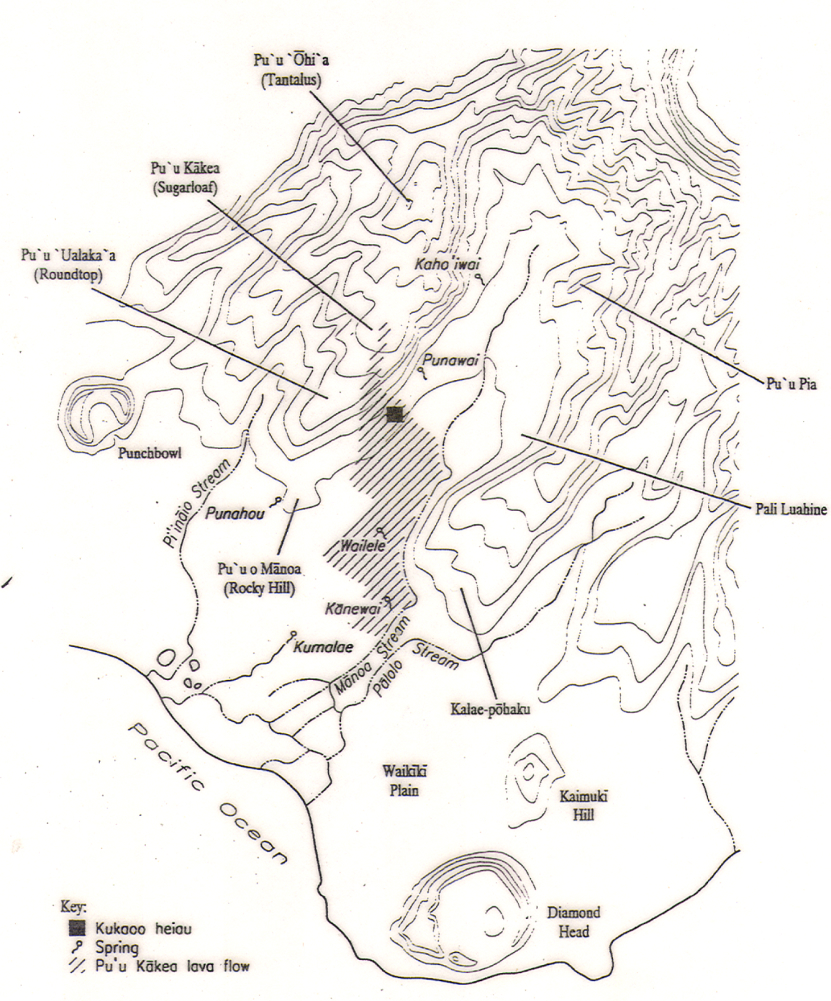Geology
Millions of years ago, volcanic eruptions gave birth to the island of O‘ahu. A “hot spot” through the earth’s mantle deep in the Pacific vented molten lava creating each of the islands as the mantle (the tectonic plate) moved steadily to the northwest. The Waiʻanae volcano was the first part of O‘ahu to emerge. Close by, but several million years later, the Koʻolau volcano rose above the sea, and as both began to build, with a central plain connecting the two and creating a single island. Wind, weather, and erosion carved out the large amphitheatre valley of Mānoa from the Koʻolau range. Evidence of volcanic activity abounds in and around Mānoa as it does throughout the islands. Pu‘u o Mānoa (Rocky Hill) is part of the early eruption near the mouth of the valley called Kahakea and is a clearly visible landmark when entering the valley via Punahou Street. A later series of eruptions, called the Honolulu Series, formed the cones of Puʻu ʻUalakaʻa (Round Top), Pu‘u Kākea (Sugarloaf) and Pu‘u ‘Ōhi‘a (Tantalus).
As recently as 67,000 years ago, Pu‘u Kākea sent a lava flow into the valley. Flowing down the west wall and through our site, it pushed the valley stream toward the east, raising the level of the lower valley floor and encircling the earlier cones of the Pu‘u o Mānoa eruptions (MacDonald, et al 447). It created the higher ground of the western valley on which our site sits and is clearly visible from many vantages. Alluvial soils subsequently backed up behind the flow to raise the upper valley floor. While alluvial soil is characteristic of the valley floor, volcanic ash and material from weathered cinders is found on the western high ground. The valley is approximately 3.4 miles long, 1.2 miles wide at the portal and 2.2 miles wide at the head.

Nearly constant northeast trade winds keep Mānoa cool and pleasant most of the year, except during muggy “Kona” weather. The rising moisture-laden trades from the northeast also bring abundant rainfall to the valley, a dominant factor in forming the valley and sculpting its walls. Precipitation decreases from head to portal. The valley head receives about 106 inches of rain a year, and the portal, near the H-1 freeway, about 35 inches a year.
Initial settlement of the Hawaiian Islands is now said to have occurred between 300 and 600 A.D. Original settlements on O‘ahu are thought to have first occurred on the windward side of the island, spreading out to the leeward side of the island by 1000 A.D. Mānoa Valley settlement probably occurred after 1400 A.D. as a logical extension of the coastal area of Waikīkī. As Native Hawaiians moved into the valley, land was cleared for taro cultivation and other crops such as breadfruit, bananas, ti, sweet potatoes, and other useful plants. Fertile and water-rich, Mānoa was an ideal place for agricultural pursuits and pleasant living.
A line from Pu‘u o Mānoa (Rocky Hill) to Pu‘u Pia was said to have divided the chiefly side of the valley on the higher western slope, from the lower valley floor occupied by the maka‘āinana, the commoners. This logical land division gave over the pleasant western slopes to the chiefs. The western slopes receive the gentle morning light and are sheltered from the harsh rays of the afternoon sun, making for an ideal residential site. From the western slope, the valley spreads out toward the east. This much larger portion of the valley is flatter, with rich alluvial soils and easy access to the abundant waters of Mānoa stream, making an ideal place for growing kalo and other native crops. Although we have no written record, we can imagine the valley in pre-contact times, a myriad of loʻi, their banks well planted with sugar cane, bananas, and other crops, and the occasional hale dotting the landscape. We can also imagine the famous sweet potatoes said to be grown in the ‘Ualaka’a area, fabled sometimes to have reached gigantic proportions.
Little is known about the specific flora of Mānoa Valley before habitation. It has been suggested that a dense rainforest once existed at the head of the valley with ‘ōhi‘a lehua being the dominant tree. Koa and the loulu palm may also have been plentiful. The thick undergrowth may have included naupaka kuahiwi, the ferns hāpu‘u, ‘ama‘u and pala‘ā, and vines such as the ‘ie‘ie. The valley floor may have been the same kind of forest. But less dense and without the thick undergrowth, and as the valley opened toward the coastal plain, the vegetation would have thinned out somewhat and consisted of more drought-tolerant plants.
Additional Resources
- Hawaiian Archipelago Formation, from Hawaiian Natural History, Ecology and Evolution by Alan C. Ziegler
- Hawaiian Topography, from Hawaiian Natural History, Ecology and Evolution by Alan C. Ziegler
- Excerpt from Volcanoes in the Sea: The Geology of Hawaii by Gordon A. MacDonald, and Agatin T. Abbott, Frank L. Peterson